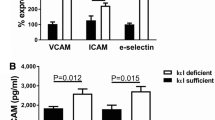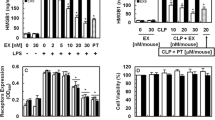Abstract
Endothelial dysfunction often accompanies sepsis. We aimed to explore the role of PCSK9 in septic endothelial dysfunction. Sepsis was induced by lipopolysaccharide (LPS) treatment of human umbilical vein endothelial cells (HUVECs) in vitro and cecal ligation and puncture (CLP) surgery in mice in vivo. Evolocumab (EVC) and Pep 2–8, PCSK9 inhibitors, were subsequently used to determine the role of PCSK9 in sepsis-induced endothelial dysfunction in vitro and in vivo, respectively. In addition, the TLR4 agonist, Kdo2-Lipid A ammonium (KLA), was used to determine the related mechanism. Protein expression of eNOS, VE-cadherin, PCSK9, TLR4, MyD88, p-p65, p65, NLRP3, ASC, and caspase-1 p20 in mice aortas and HUVECs was measured by western blotting, while mRNA expression of TNFα, IL-1β, and IL-18 was determined by qRT-PCR. The level of inflammatory cytokines of mouse aortas was visualized by immunohistochemistry. Vasodilation of the aorta was detected by vascular reactivity experiments. The 96-h survival rate after CLP was assessed. Our findings showed that the expression of eNOS and VE-cadherin decreased, and PCSK9 expression increased, in septic HUVECs or mice. Inhibition of PCSK9 increased eNOS and VE-cadherin expression. Activation of the TLR4/MyD88/NF-κB and NLRP3 pathways may be responsible for PCSK9-induced endothelial dysfunction in sepsis. Vascular reactivity tests and survival studies showed that inhibition of PCSK9 could prevent the decrease in endothelium-dependent vasodilation function and improve the survival rates of septic mice. In summary, our results suggested that increased PCSK9 expression during sepsis activated the TLR4/MyD88/NF-κB and NLRP3 pathways to induce inflammation, which resulted in vascular endothelial dysfunction and decreased survival rates. Thus, inhibition of PCSK9 may be a potential clinical therapeutic target to improve vascular endothelial function in sepsis.







Similar content being viewed by others
Availability of Data and Materials
The data and materials used in this study are available from the corresponding authors upon reasonable request.
References
Hollenberg, S.M., and M. Singer. 2021. Pathophysiology of sepsis-induced cardiomyopathy. Nature Reviews. Cardiology 18: 424–434.
Lelubre, C., and J.L. Vincent. 2018. Mechanisms and treatment of organ failure in sepsis. Nature Reviews. Nephrology 14: 417–427.
Bernardin, G., C. Pradier, F. Tiger, P. Deloffre, and M. Mattei. 1996. Blood pressure and arterial lactate level are early indicators of short-term survival in human septic shock. Intensive Care Medicine 22: 17–25.
Angé, M., J. De Poortere, A. Ginion, S. Battault, M. Dechamps, G.G. Muccioli, M. Roumain, J. Morelle, S. Druart, T. Mathivet, L. Bertrand, D. Castanares-Zapatero, S. Horman, and C. Beauloye. 2021. Canagliflozin protects against sepsis capillary leak syndrome by activating endothelial α1AMPK. Scientific Reports 11: 13700.
Pi, Q.Z., X.W. Wang, Z.L. Jian, D. Chen, C. Zhang, and Q.C. Wu. 2021. Melatonin alleviates cardiac dysfunction via increasing Sirt1-mediated beclin-1 deacetylation and autophagy during sepsis. Inflammation 44: 1184–1193.
Angus, D.C., and T. van der Poll. 2013. Severe sepsis and septic shock. The New England Journal of Medicine 369: 840–851.
Rajendran, P., T. Rengarajan, J. Thangavel, Y. Nishigaki, D. Sakthisekaran, G. Sethi, and I. Nishigaki. 2013. The vascular endothelium and human diseases. International Journal of Biological Sciences 9: 1057–1069.
Ince, C., P.R. Mayeux, T. Nguyen, H. Gomez, J.A. Kellum, G.A. Ospina-Tascón, G. Hernandez, P. Murray, D. De Backer, and A.D.Q.I.X.I.V. Workgroup. 2016. The endothelium in sepsis. Shock 45: 259–270.
Joffre, J., J. Hellman, C. Ince, and H. Ait-Oufella. 2020. Endothelial responses in sepsis. American Journal of Respiratory and Critical Care Medicine 202: 361–370.
Li, Z., M. Yin, H. Zhang, W. Ni, R.W. Pierce, H.J. Zhou, and W. Min. 2020. BMX represses thrombin-PAR1-mediated endothelial permeability and vascular leakage during early sepsis. Circulation Research 126: 471–485.
Lambert, G., B. Sjouke, B. Choque, J.J. Kastelein, and G.K. Hovingh. 2012. The PCSK9 decade. Journal of Lipid Research 53: 2515–2524.
Ragusa, R., G. Basta, D. Neglia, R. De Caterina, S. Del Turco, and C. Caselli. 2021. PCSK9 and atherosclerosis: Looking beyond LDL regulation. European Journal of Clinical Investigation 51: e13459.
Feng, Q., W.Q. Wei, S. Chaugai, B.G. Carranza Leon, V. Kawai, D.A. Carranza Leon, L. Jiang, X. Zhong, G. Liu, A. Ihegword, C.M. Shaffer, M.F. Linton, C.P. Chung, and C.M. Stein. 2019. A genetic approach to the association between PCSK9 and sepsis. JAMA Network Open 2: e1911130.
Berger, J.M., A. Loza Valdes, J. Gromada, N. Anderson, and J.D. Horton. 2017. Inhibition of PCSK9 does not improve lipopolysaccharide-induced mortality in mice. Journal of Lipid Research 58: 1661–1669.
Ding, Z., N. Pothineni, A. Goel, T.F. Lüscher, and J.L. Mehta. 2020. PCSK9 and inflammation: Role of shear stress, pro-inflammatory cytokines, and LOX-1. Cardiovascular Research 116: 908–915.
Yuan, Y., W. Wu, S. Sun, Y. Zhang, and Z. Chen. 2020. PCSK9: A potential therapeutic target for sepsis. Journal of Immunology Research 2020: 2687692.
Yu, H., Q. Liu, G. Chen, L. Huang, M. Luo, D. Lv, and S. Luo. 2022. SIRT3-AMPK signaling pathway as a protective target in endothelial dysfunction of early sepsis. International Immunopharmacology 106: 108600.
Tourki, B., L.M. Black, V. Kain, and G.V. Halade. 2021. Lipoxygenase inhibitor ML351 dysregulated an innate inflammatory response leading to impaired cardiac repair in acute heart failure. Biomedicine & Pharmacotherapy = Biomédecine & Pharmacothérapie 139: 111574.
Palee, S., C.M. McSweeney, C. Maneechote, D.M. Moisescu, T. Jaiwongkam, S. Kerdphoo, S.C. Chattipakorn, and N. Chattipakorn. 2019. PCSK9 inhibitor improves cardiac function and reduces infarct size in rats with ischaemia/reperfusion injury: Benefits beyond lipid-lowering effects. Journal of Cellular and Molecular Medicine 23: 7310–7319.
You, Y., W. Tan, Y. Guo, M. Luo, F.F. Shang, Y. Xia, and S. Luo. 2020. Progesterone promotes endothelial nitric oxide synthase expression through enhancing nuclear progesterone receptor-SP-1 formation. American Journal of Physiology. Heart and Circulatory Physiology 319: H341–H348.
Luo, M., J. Meng, J. Yan, F. Shang, T. Zhang, D. Lv, C. Li, X. Yang, and S. Luo. 2020. Role of the nucleotide-binding domain-like receptor protein 3 inflammasome in the endothelial dysfunction of early sepsis. Inflammation 43: 1561–1571.
Tang, Z.H., J. Peng, Z. Ren, J. Yang, T.T. Li, T.H. Li, Z. Wang, D.H. Wei, L.S. Liu, X.L. Zheng, and Z.S. Jiang. 2017. New role of PCSK9 in atherosclerotic inflammation promotion involving the TLR4/NF-κB pathway. Atherosclerosis 262: 113–122.
Esposito, S., G. De Simone, G. Boccia, F. De Caro, and P. Pagliano. 2017. Sepsis and septic shock: New definitions, new diagnostic and therapeutic approaches. Journal of Global Antimicrobial Resistance 10: 204–212.
Rello, J., F. Valenzuela-Sánchez, M. Ruiz-Rodriguez, and S. Moyano. 2017. Sepsis: A review of advances in management. Advances in Therapy 34: 2393–2411.
Pool, R., H. Gomez, and J.A. Kellum. 2018. Mechanisms of organ dysfunction in sepsis. Critical Care Clinicss 34: 63–80.
Evans, L., A. Rhodes, W. Alhazzani, M. Antonelli, C.M. Coopersmith, C. French, F.R. Machado, L. Mcintyre, M. Ostermann, H.C. Prescott, C. Schorr, S. Simpson, W.J. Wiersinga, F. Alshamsi, D.C. Angus, Y. Arabi, L. Azevedo, R. Beale, G. Beilman, E. Belley-Cote, L. Burry, M. Cecconi, J. Centofanti, A. Coz Yataco, J. De Waele, R.P. Dellinger, K. Doi, B. Du, E. Estenssoro, R. Ferrer, C. Gomersall, C. Hodgson, M.H. Møller, T. Iwashyna, S. Jacob, R. Kleinpell, M. Klompas, Y. Koh, A. Kumar, A. Kwizera, S. Lobo, H. Masur, S. McGloughlin, S. Mehta, Y. Mehta, M. Mer, M. Nunnally, S. Oczkowski, T. Osborn, E. Papathanassoglou, A. Perner, M. Puskarich, J. Roberts, W. Schweickert, M. Seckel, J. Sevransky, C.L. Sprung, T. Welte, J. Zimmerman, and M. Levy. 2021. Surviving sepsis campaign: International guidelines for management of sepsis and septic shock 2021. Intensive Care Medicine 47: 1181–1247.
Lipinska-Gediga, M. 2016. Sepsis and septic shock-is a microcirculation a main player. Anaesthesiology Intensive Therapy 48: 261–265.
Sharawy, N., and C. Lehmann. 2015. New directions for sepsis and septic shock research. The Journal of Surgical Research 194: 520–527.
Lammert, E., and J. Axnick. 2012. Vascular lumen formation. Cold Spring Harbor Perspectives in Medicine 2: a006619.
Godo, S., and H. Shimokawa. 2017. Endothelial functions. Arteriosclerosis, Thrombosis, and Vascular Biology 37: e108–e114.
Volk, T., and W.J. Kox. 2000. Endothelium function in sepsis. Inflammation Research: Official Journal of the European Histamine Research Society 49: 185–198.
Wu, W., P. Geng, J. Zhu, J. Li, L. Zhang, W. Chen, D. Zhang, Y. Lu, and X. Xu. 2019. KLF2 regulates eNOS uncoupling via Nrf2/HO-1 in endothelial cells under hypoxia and reoxygenation. Chemico-biological Interactions 305: 105–111.
Vestweber, D. 2008. VE-cadherin: The major endothelial adhesion molecule controlling cellular junctions and blood vessel formation. Arteriosclerosis, Thrombosis, and Vascular Biology 28: 223–232.
Pasta, A., A.L. Cremonini, L. Pisciotta, A. Buscaglia, I. Porto, F. Barra, S. Ferrero, C. Brunelli, and G.M. Rosa. 2020. PCSK9 inhibitors for treating hypercholesterolemia. Expert Opinion On Pharmacotherapy 21: 353–363.
Innocenti, F., A.M. Gori, B. Giusti, C. Tozzi, C. Donnini, F. Meo, I. Giacomelli, M.L. Ralli, A. Sereni, E. Sticchi, I. Tassinari, R. Marcucci, and R. Pini. 2021. Plasma PCSK9 levels and sepsis severity: An early assessment in the emergency department. Clinical and Experimental Medicine 21: 101–107.
Dwivedi, D.J., P.M. Grin, M. Khan, A. Prat, J. Zhou, A.E. Fox-Robichaud, N.G. Seidah, and P.C. Liaw. 2016. Differential expression of PCSK9 modulates infection, inflammation, and coagulation in a murine model of sepsis. Shock 46: 672–680.
Zusso, M., V. Lunardi, D. Franceschini, A. Pagetta, R. Lo, S. Stifani, A.C. Frigo, P. Giusti, and S. Moro. 2019. Ciprofloxacin and levofloxacin attenuate microglia inflammatory response via TLR4/NF-kB pathway. Journal of Neuroinflammation 16: 148.
Ye, M., Y. Tang, J. He, Y. Yang, X. Cao, S. Kou, L. Wang, L. Sheng, and J. Xue. 2021. Alleviation of non-alcoholic fatty liver disease by Huazhi Fugan Granules is associated with suppression of TLR4/NF-κB signaling pathway. Clínica e investigación en arteriosclerosis : Publicación oficial de la Sociedad Española de Arteriosclerosis 33: 257–266.
Lawrence, T. 2009. The nuclear factor NF-kappaB pathway in inflammation. Cold Spring Harbor Perspectives in Biology 1: a001651.
Lv, D., M. Luo, J. Yan, X. Yang, and S. Luo. 2021. Protective effect of sirtuin 3 on CLP-induced endothelial dysfunction of early sepsis by inhibiting NF-κB and NLRP3 signaling pathways. Inflammation 44: 1782–1792.
Sutterwala, F.S., S. Haasken, and S.L. Cassel. 2014. Mechanism of NLRP3 inflammasome activation. Annals of the New York Academy of Sciences 1319: 82–95.
Sharif, H., L. Wang, W.L. Wang, V.G. Magupalli, L. Andreeva, Q. Qiao, A.V. Hauenstein, Z. Wu, G. Núñez, Y. Mao, and H. Wu. 2019. Structural mechanism for NEK7-licensed activation of NLRP3 inflammasome. Nature 570: 338–343.
Funding
This work was supported by the National Natural Science Foundation of China (82070238).
Author information
Authors and Affiliations
Contributions
SL and YX conceived this idea. LH and ZC performed the experiments in vitro. LH and ZL performed the experiments in vivo. YL participated in the collection, analysis, and interpretation of the data. LH wrote the manuscript. All authors read and approved the final manuscript.
Corresponding authors
Ethics declarations
Ethics Approval and Consent to Participate
Animal experiments were performed in accordance with the National Animal Protection and Use Guidelines and approved by the local ethical committee of the First Affiliated Hospital of Chongqing Medical University (No: 2021–706). The newborn umbilical cord was obtained from the First Affiliated Hospital of Chongqing Medical University, and the experiments were approved by the local ethical committee of the First Affiliated Hospital of Chongqing Medical University (No: 2021–689).
Consent for Publication
The manuscript has been approved by all authors for publication.
Competing Interests
The authors declare no competing interests.
Additional information
Publisher's Note
Springer Nature remains neutral with regard to jurisdictional claims in published maps and institutional affiliations.
Rights and permissions
Springer Nature or its licensor holds exclusive rights to this article under a publishing agreement with the author(s) or other rightsholder(s); author self-archiving of the accepted manuscript version of this article is solely governed by the terms of such publishing agreement and applicable law.
About this article
Cite this article
Huang, L., Li, Y., Cheng, Z. et al. PCSK9 Promotes Endothelial Dysfunction During Sepsis Via the TLR4/MyD88/NF-κB and NLRP3 Pathways. Inflammation 46, 115–128 (2023). https://doi.org/10.1007/s10753-022-01715-z
Received:
Revised:
Accepted:
Published:
Issue Date:
DOI: https://doi.org/10.1007/s10753-022-01715-z




